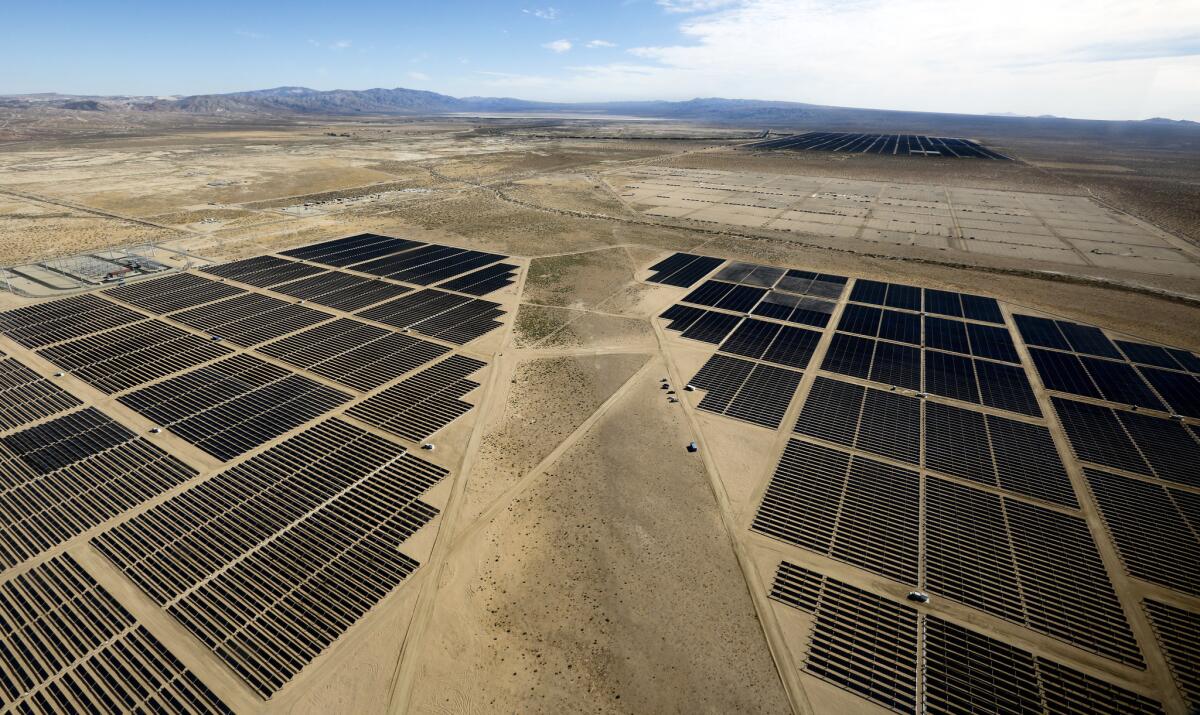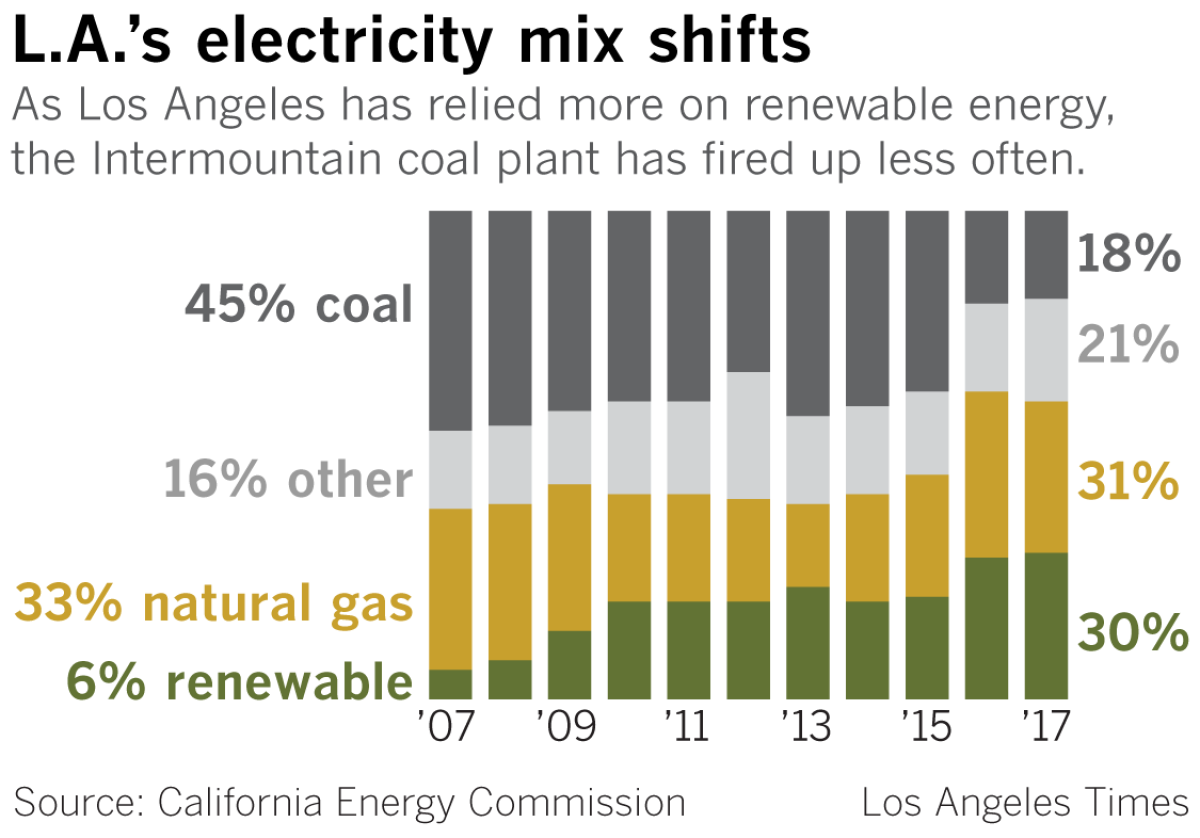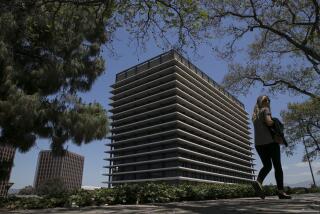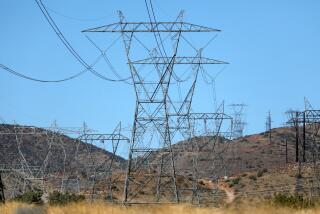Los Angeles has lined up record-cheap solar power. But there’s a problem

Los Angeles has been sitting on a contract for record-cheap solar power for more than a month — and city officials declined to approve it Tuesday because of concerns raised by the city-run utility’s labor union, which is still fuming over Mayor Eric Garcetti’s decision to shut down three gas-fired power plants.
Under the 25-year contract with developer 8minute Solar Energy, the Los Angeles Department of Water and Power would pay less than 2 cents per kilowatt-hour — a number city officials and independent experts say would be the lowest price ever paid for solar power in the United States, and cheaper than the cost of electricity from a typical natural gas-fired power plant.
In addition to 400 megawatts of solar power, the Eland project would include at least 200 megawatts of lithium-ion batteries, capable of storing solar power during the day and injecting it into the grid for four hours each night.
The combined price to L.A. ratepayers of the solar and storage would be 3.3 cents per kilowatt-hour — also a record low for this type of contract.
But LADWP’s Board of Commissioners voted not to send the contract to the City Council for approval, after utility staff said concerns had been raised by the International Brotherhood of Electrical Workers Local 18, which represents utility employees.
In recent months, IBEW Local 18 has run television and radio ads attacking Garcetti’s Green New Deal initiative, which includes the retirement of three coastal gas plants that employ more than 400 LADWP workers.
City officials say none of the LADWP workers at those plants will lose their jobs. But that hasn’t satisfied the union, which has warned that Garcetti’s plans for fighting climate change could drive up electricity prices and eliminate good-paying jobs.
Brian D’Arcy, IBEW Local 18’s top executive, called the mayor’s decision to shut down the three gas plants a “childlike proposal” that could lead to more power outages in an interview earlier this year.
The Eland project, which is planned for the Mojave Desert north of Los Angeles, wouldn’t replace those gas plants. But it could help L.A. reduce its reliance on gas, which has become California’s largest electricity source as utilities look for evening power sources to fill in for solar after the sun goes down.
With 200 megawatts of batteries, Eland could produce power at full strength for 50% of each day, according to Tom Buttgenbach, 8minute’s president and chief executive. By comparison, solar farms without energy storage typically have capacity factors in the 25%-30% range in the sunny desert Southwest.
“You can totally control how much power it produces. The technology is very, very reliable,” Buttgenbach said.
Buttgenbach attributed Eland’s record-low price to several factors, including cheap land costs and some of the best solar radiation in the country.
He also noted that Los Angeles has an option to increase the amount of battery storage from 200 megawatts to 300 megawatts, for an additional cost. That would bring the solar-plus-storage price to 3.96 cents per kilowatt-hour — still cheaper than electricity from gas under most circumstances, based on cost estimates from the U.S. Energy Information Administration and the investment bank Lazard. And the plant’s capacity factor would rise to 60%.
LADWP staff struggled to explain to the Board of Commissioners Tuesday why Local 18 had objected to the Eland project. The utility’s director of labor relations, Deitra Fernandes, said the union might be worried about the developer hiring out-of-state workers.
But 8minute spokesman Jeff McKay said the company plans to sign a Project Labor Agreement this week with IBEW Local 428 in Kern County, with the entire workforce coming from California.
Asked about the union’s opposition, an IBEW Local 18 spokesman sent a short emailed statement saying that LADWP “has not complied with its contractual obligations for this deal.” The statement didn’t provide details of how the utility hasn’t complied.
“Local 18 is at the forefront of building some of the largest renewable energy projects in the state, however concerns needed to be raised,” he said.

The LADWP board is expected to consider the Eland contract again at its next board meeting on Sept. 10. There’s a tight timeline: 8minute’s pricing is dependent on the federal investment tax credit for solar energy, which is scheduled to drop to 26% at the end of 2019 from 30% now. The company needs to start construction by December to qualify for the 30% tax credit, which means it needs contract approval from LADWP and the City Council before then.
“The sooner the better for us,” McKay said. “If it carries on another month, we could still make it work.”
Two LADWP commissioners, board President Mel Levine and Jill Banks Barad, voted to approve the Eland contract on Tuesday, with the understanding that utility staff would meet with the union this week to hear its concerns. But Cynthia McClain-Hill voted no, and Susana Reyes, a recent Garcetti appointee, abstained. With the fifth commissioner, Christina Noonan, absent, there wasn’t a majority to approve the contract.
“I would be concerned about unnecessarily creating problems with labor around a project of this importance,” McClain-Hill said.
On Wednesday, three Los Angeles City Council members — Mike Bonin, Paul Koretz and Paul Krekorian — sent a letter to the LADWP commissioners saying they were “shocked and dismayed” to read that the board had declined to sign off on the solar deal.
“Not approving this contract is fiscally irresponsible and an act of surrender in the battle against the climate crisis that threatens our children and our environment,” they wrote.
Eland would supply L.A. with enough electricity to meet 6% to 7% of the city’s annual need. It would go a long way toward helping Los Angeles meet state mandates of 60% renewable energy by 2030 and 100% climate-friendly energy by 2045. Today, LADWP’s electricity supply is about one-third renewable.
The cost of solar power has fallen 85% since 2010, according to the research and consulting firm Bloomberg New Energy Finance. Cheap energy storage is a newer phenomenon, but analysts say the technology may be in the early stages of a similar cost decline. BloombergNEF reported earlier this year that battery costs had fallen 35% since the first half of 2018. Costs will drop an additional 64% over the next two decades, the firm predicted.
The market for large-scale solar-plus-storage has just started to take shape, according to Yayoi Sekine, a New York-based analyst for BloombergNEF. Most of the projects proposed or contracted so far have been in Southwestern states such as Arizona, California and Nevada, as well as Hawaii.
“Sunny states are probably the best economic case for where solar and storage are going to start,” Sekine said.
Staff writer Emily Alpert Reyes contributed to this report.







